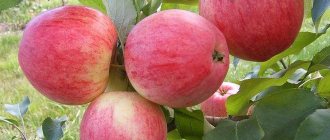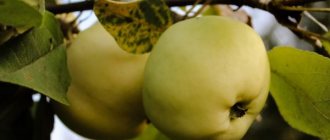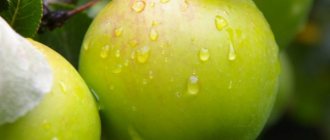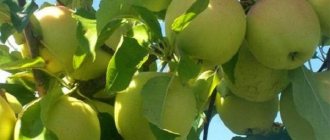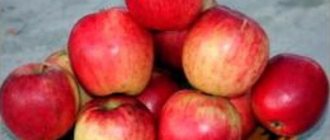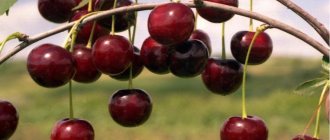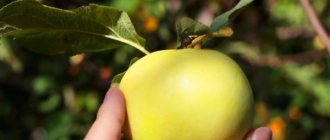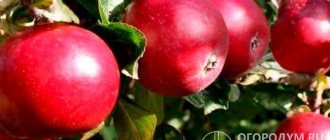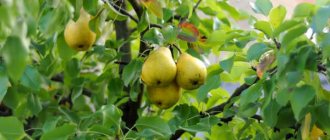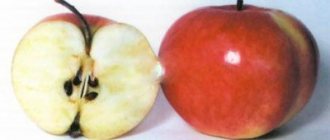Characteristics
The summer variety Alyonushka begins to bear fruit early, produces about 60-80 kg of fruit in the first 10 years, then this figure decreases. The medium-sized crop is very easy to care for. Due to this, it has increased frost resistance. This form is convenient to cover, and also reduces crop losses because it is much more convenient to collect it.
Advantages and disadvantages
For a number of positive properties, this variety of apple tree is very popular among gardeners. These include:
- resistance to low temperatures;
- the ability to quickly regenerate in case of damage;
- bountiful harvest;
- precociousness;
- small size of tasty and healthy fruits;
- universal purpose of fruits.
But it is worth noting the disadvantages. Among them:
- lack of immunity to scab and other apple diseases;
- the small size of summer fruits and short shelf life are also considered disadvantages. But this drawback is controversial, because you can prepare a large number of different delicious desserts from them.
Description of the tree
A mature Alyonushka tree is a natural semi-dwarf, usually reaching 3 meters in height, no more, while the crown width can reach 2 meters. During the first 2-3 years, growth is quite rapid, but when fruits appear, it stops.
Description of fruits
Small apples are produced annually in sufficient quantities. However, after 10 years of fruiting, regular and abundant, apple trees acquire a tendency to periodicity.
The taste of the fruit is quite interesting, apparently, this is due to the wildness in the genes. The juicy apples are slightly sweet, but with an unusual spicy sourness. Thanks to this, they can be used for making compote, cider, as well as dried fruits and, of course, consumed fresh.
Fruits of the Alyonushka variety.
Low temperature resistance
Winter hardiness is a huge achievement of this variety and its pride. The culture survived even the most severe frost of the seventies, an indicator of 48 degrees, and quickly recovered. If some young shoots may be slightly affected, they move away very quickly.
But resistance to other climatic conditions is rather mediocre. Thus, Alenushkino does not tolerate drought and high temperatures and needs constant watering.
Immunity to diseases
The Alyonushka apple tree cannot boast of disease resistance, although under normal conditions it does not get particularly sick. But, if a source of infection appears in the garden, then the crop can pick it up. And also during epidemics, severe spread of diseases or high humidity, scab may occur on the apple tree.
Breeding history
This hybrid was bred in the second half of the 20th century by Krasnodar breeders A.S. Tolmachev and N.N. Tikhonov. To obtain this variety of apples, they used Papirovka, which is common in the Baltic countries. It is thanks to this variety that Alenka is distinguished by its early harvest ripening, fruit aroma and high yield level.
The first few years after breeding, the variety was actively used in industry and grown in the fields. However, today Alyonushka is also grown by ordinary gardeners in their summer cottages.
Ripening and fruiting
The indicators and characteristics of the ripening and fruiting of the crop are typical for summer varieties, but taking into account the fact that the apple tree also survives in extreme conditions. All this must be taken into account before planting the plant on the site.
Flowering time
The beginning of flowering usually occurs in the second half of May, but in warm regions it may shift to the beginning of the month. Flowering duration is about 7-10 days.
Fruit ripening
A summer ripening variety, you can start harvesting it in mid-August. But, depending on the climatic conditions of the region, options are possible - a week in one direction or the other.
Harvest storage
The usual shelf life of fruit is about 45 days, but this is the best indicator. It happens much less. During this period, the apples may begin to rot and become soft and loose. Therefore, various jams, as well as drinks and compotes are prepared from them immediately after harvesting.
Technology of planting young seedlings
The main task of the farmer at the initial stage is to choose the right planting material and carry out pre-planting preparation. The rate of plant survival on the site, and, accordingly, the level of productivity in the future will directly depend on this.
Did you know? In an hour, planting trees on an area of 1 hectare absorbs the same amount of carbon dioxide that 200 people emit in the same period of time.
The right choice of seedlings
When choosing seedlings, follow the following rules:
Planting material should be purchased at sales points that offer plants zoned in a specific area. Select seedlings that are 1-2 years old - they take root on the site faster, unlike five-year-old specimens. Carefully evaluate the condition of the trunk - it should be smooth, with uniformly colored wood. One-year-old plants consist of a main conductor; two-year-old plants already have skeletal branches located in relation to the main trunk at an angle of 45° to 90°. If the purchase is made immediately before planting, it is better to give preference to bare-root seedlings (they are dug up before sale and then packaged in bags for transportation). If you cannot plant a seedling right away, it is better to buy a plant with a closed root - they are sold in the container in which they were originally grown. Always meticulously inspect the root collar - it is located 5 cm above the central taproot. In this place the trunk is slightly bent, and a healed wound or stump from the cut rootstock is clearly visible on the surface. If this wound is fresh, then you should not buy the plant, as it will not take root well. If possible, the condition of the root system should be assessed - it consists of several thick stem shoots and a large number of additional roots. Colored evenly, light gray
The root length should not be less than 30 cm
Pay attention to the description on the tag - it indicates the name of the variety, the name of the rootstock, the date of grafting and the regionalization of the plant
Optimal time and place for landing
Planting time depends on the region of planned cultivation:
- in areas with a cool climate - before buds open, in April - mid-May, depending on the weather;
- in areas with mild, warm weather conditions - in September - early October, but no later than a month before the expected frost.
The planting site should be open, well lit, but protected from drafts. The plant does not develop well in shade and partial shade. The crop is demanding on soil quality. Grows well on chernozems, loams or meadow soils. Sandstones are not suitable for this variety.
If the soil is poor, then six months before planting, 10 kg of peat and sand, 20 kg of fresh manure and 500 g of superphosphate are added to each square meter of digging to a depth of 30 cm. If the level of the fertile layer is 15 cm, then there is no need to fertilize it additionally. It will be enough to carry out deep loosening 2-3 times.
Landing technology
A month before planting, the soil is loosened to a depth of 30 cm and disinfected with a 3% solution of copper sulfate. A week later, they begin to prepare a planting hole measuring 60x80 cm.
The top half of the soil is mixed with:
- 20 kg of compost or rotted manure;
- 300 g nitrophoska.
After this, pour 30 liters of warm (+30°C) water and leave for 3 weeks. Similar holes are dug for pollinators.
Important! A distance of at least 7 m must be maintained from the Modi apple tree to any other fruit crops. The distance between trees and in rows is calculated based on the type of rootstock:
The distance between trees and in rows is calculated based on the type of rootstock:
- vigorous - 6x6 m;
- dwarf - 4x3 m;
- plum/tall cherry - 5x4 m;
- plum/cherry low-growing - 3x3 m.
Landing Features
Proper planting is the key to normal development of the crop. Therefore, a number of important requirements must be observed.
Place
The landing site should be well sunny, but at the same time located so that the apple tree is not affected by strong gusts of cold wind. Due to the compactness of the tree, there is no need for a large distance from other plantings; a distance of 3 meters is sufficient.
Landing dates
Planting is carried out in autumn and spring, but both have their own nuances. The positive aspects of autumn planting are that over the winter the roots of the plant will adapt to environmental conditions and in the spring the apple tree will quickly begin to grow.
But if you plant it incorrectly, prepare it poorly, or choose one that is not prepared for a certain area, the plant will freeze. Then in the spring the restoration process will begin first, and then the apple tree will begin to grow.
When planting in spring, the crop will not have such stress, but it may suffer from a lack of moisture, which is very important for normal development. You will need to monitor it closely to prevent it from drying out.
Fertilizers in the planting hole.
Landing technology
Planting begins with the immediate preparation of the hole. To do it correctly you need:
- prepare it with a size of 50 by 50 cm, this is enough for a small crop;
- add humus and mineral fertilizers, mix the top layer of nutrient soil;
- Next, a small hill is made, on which the seedling is placed and the roots are carefully straightened;
- everything is covered with soil;
- a peg for support is installed on the north side;
- after the soil has been compacted after watering, it is necessary to ensure that the grafting site looks 5-7 cm above the ground level.
Finally, you need to make rollers and boundaries for watering the tree trunk circle.
Apple tree Alyonushka: variety description and characteristics
Apple tree Alyonushka: photo of variety
The Alyonushka apple tree was bred in the last century by domestic breeders through crossing Papirovka and Ranetka. From 1960 to the present, this apple tree has been very popular in Russia. It is ideally suited for cultivation in the Siberian Federal District; it is not surprising that this variety is considered practically the most famous in this region of Russia. This tree has a fairly dense crown and a lot of foliage. The bark of the Alyonushka apple tree variety is brown, but if the crown is poorly illuminated by the sun, it will become olive-colored. The shoots of the plant are penetrating. Apples are usually formed on fruit twigs, annual shoots. The branches have the same brown color, they are slightly drooping, and not very large in size. Lentils are also small, and it should be noted that there are relatively few of them. The foliage of these trees is short-pointed, ovate, the leaf blades are serrated at the edges, the leaves have a beautiful light green color with a blue tint, they are usually matte and quite drooping. The flowers of the plant are snow-white, quite voluminous, and the buds themselves are slightly pinkish. Each flower produces five petals, which are also ovoid in shape. Despite the fact that apples are light in weight, they are not only round, but also very even, so the marketable appearance of the fruit is excellent. Closer to the calyx, the apples begin to narrow, slight ribbing is noticeable on the sides, most fruits have a small seam, sometimes the apples become flattened. If we talk about the color of the fruit, then the fruits are red-pink, with a blush; the interesting thing is that the longer the apple sits, the brighter these little lines will become. The color of the fruit is integumentary. You can notice a slight waxy coating on the skin, so the surface of the apples is shiny and fairly smooth, the stalks are thin, but the stalks at the base are quite thick, so the product always sticks well to the branches. The fruit pulp is juicy, dense, snow-white. The taste of the fruit is sweet with pleasant sourness and spice, the grain size is large, as we noted earlier, the apples are well attached to the branches, quite tightly.
Features of agricultural technology
The culture is quite responsive to fertilizing and watering. But there are particularities of care; all procedures must be carried out correctly.
Watering
The Alyonushka apple tree does not like a lack of moisture and can tolerate drought with losses, so it is necessary to add water several times a season.
The schedule is like this:
- in early spring before the buds bloom;
- at the beginning of flowering;
- after flowering;
- in the summer before harvest;
- in autumn, moisture-charging irrigation.
Under normal conditions, you need to apply 30-40 liters for each tree.
Fertilizers
In the first year after planting, the apple trees are not fed, because a sufficient amount of fertilizer was placed in the hole. But from the second year you can use supplements.
The deposit must be made according to the following schedule:
- in spring or early summer nitrogen and rotted manure;
- in mid-summer, phosphorus and potassium are needed for a full number of ovaries;
- Wood ash and compost will be needed at the end of the season.
Trimming and shaping
The first formation of the crop can be already in the first year if planting was carried out in the spring. Then every year the shoots are partially removed to ensure the correct shape.
At the same time, sanitary pruning is also carried out. Broken or dried branches and those that prevent others from growing are removed. The Alyonushka variety responds very favorably to pruning and tolerates it easily. Moreover, the culture can be formed in a creeping form or even on a trellis.
Pollinators
The apple tree needs to be planted in a neighboring area of pollinator crops because it itself is sterile. It is necessary that apple trees bloom within reach at the same time. The varieties Yunost, Zarya, Lada, and Flashlight are considered the best pollinators.
Preparing for winter
Even the hardiest apple tree needs to be properly prepared for cold weather. Therefore, after harvesting, the following is carried out:
- sanitary pruning;
- feeding;
- moisture-charging irrigation.
After this, you need to carefully inspect the tree for damage or pests, clean and heal wounds if necessary, and whiten the trunk.
Spruce branches are laid out in the circle around the trunk; spruce branches will insulate the crop itself well, especially in cold climates, and protect it from hungry animals.
Growing in regions
A feature of the crop is its high resistance to cold, so it can be grown even in northern regions. However, it is best to form creeping forms there to make it more convenient to cover for the winter.
In the central regions, growing Alyonushka will give the greatest results; there are no sudden temperature changes or severe drought. However, if the summer is quite cold, the taste of the product may deteriorate slightly. A sufficient amount of moisture is also equally important. In drought conditions, the crop will need to be watered additionally.
Winter hardiness and disease resistance
Many residents of northern regions with a changeable and harsh climate who plan to grow Alyonushka are interested in the winter hardiness of the variety. Experienced breeders and gardeners are confident that this variety can be considered one of the most frost-resistant. Apple trees can survive even serious temperature drops down to 45 degrees below zero. The trees also have average resistance to high temperatures and droughts.
However, Alenka copes much worse with illnesses. Most often, immature apple tree seedlings suffer from diseases, which can die from scab or pests.
Reviews
Vasily, 50 years old, Mirny: “I like Alyonushkino, there are no problems with him, not even any special care. Sometimes, when there is scab in the garden, I also get sick. There are not many apples, but there are enough to eat fresh and for drying.”
Victoria, 36 years old, Mukhino: “I grow Alyonushka on a trellis, it looks very beautiful. The apple tree is small, the taste is not for everyone, but the children like it"
Zakhar Petrovich, 63 years old, Murmansk: “They praised the tree so much that I bought one for myself. There’s nothing special, I’m freezing, not too much, but the young branches are. That and two buckets of apples.”
